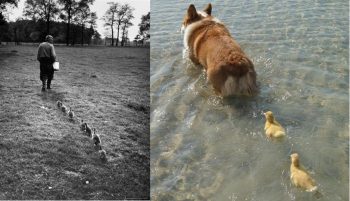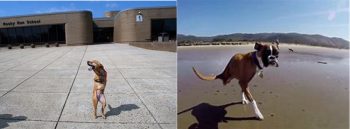By Vidya Rajan, Columnist, The Times
 One of the unexpected sights driving around my neighborhood in Chester county is seeing an adult male peacock with a magnificent tail walking about the streets. Peacocks are native to the tropics, and are the national bird of India. This peacock was probably bought as a pet, maybe as a pair, maybe alone. He’s since become feral, and has no partner. He has a big range and has been in the area at least 8 years. I have seen him wandering about 5 miles away and heard his penetrating call “kia, kia, kia” from a variety of directions. Peacocks call as a signal to other peacocks – he’s probably in search of a female, or females, since male peacocks have harems. But this poor peacock has been ranging far and wide, following his instinct to find a mate, calling “kia, kia, kia” and waiting for an answer that never comes. I often wonder that he persists in his search. Have the years of unrequited yearning not put paid to his optimism? Is it the season that stimulates an urge to call?
One of the unexpected sights driving around my neighborhood in Chester county is seeing an adult male peacock with a magnificent tail walking about the streets. Peacocks are native to the tropics, and are the national bird of India. This peacock was probably bought as a pet, maybe as a pair, maybe alone. He’s since become feral, and has no partner. He has a big range and has been in the area at least 8 years. I have seen him wandering about 5 miles away and heard his penetrating call “kia, kia, kia” from a variety of directions. Peacocks call as a signal to other peacocks – he’s probably in search of a female, or females, since male peacocks have harems. But this poor peacock has been ranging far and wide, following his instinct to find a mate, calling “kia, kia, kia” and waiting for an answer that never comes. I often wonder that he persists in his search. Have the years of unrequited yearning not put paid to his optimism? Is it the season that stimulates an urge to call?
The field of “ethology” studies behavior, and instinct is defined as behavior that is not learned by observation. Thus it is nature, not nurture that guides instinct. The Austrian Nobel Prize-winning biologist Nicholas Tinbergen [1] originated the study of animal behavior in the 1930s, and received a Nobel Prize in 1973 with two other giants in the field, Konrad Lorenz[2] and Karl von Frisch[3]. Lorenz memorably demonstrated the instinct of ducklings to follow their mother in a line. He did this by hatching young ducklings and making sure that he was the first object that the hatchlings saw. The hatchlings therefore instinctively assumed him to be their mother and followed him around the farm in single file. In ancient Rome and China, imprinting was used to control domesticated bird behavior. Recently, it has been useful in bird recovery and release programs because it allows the hatchling to be fostered to a sock animal shaped like a bird to that the workers can wear on their hands to feed and groom the young bird. Eventually, the bird can be released to the wild more easily.

Figure: Konrad Lorenz (left) and right, a dog with their rows of imprinted ducklings. Reproduced from http://psychologystandard.com/evolutionary-psychology/ and https://www.themichaelteaching.com/michael/imprinting-and-personality/ under Fair Use copyright law.
Tinbergen studied the instinct of male stickleback fish to attack other males. He noted that when a male stickleback was faced with a mirror, it would react as if it was confronted with another male stickleback. He also investigated the homing behavior of beewolves (a ground-nesting wasp with a taste for bees) and types of eggs birds prefer to brood: “…eggs with exaggerated markings in the form of size, spots and color” according to the Nobel Prize citation.)
Beekeepers know all about Karl von Frisch’s research into the “waggle dance” of honeybees. Von Frisch also demonstrated that bees had color vision (confirming research by Charles Henry Turner) and that they orient to polarized light from the sun during the day. He also posited that the magnetic field of the Earth influenced honeycomb structure. He showed that swarming bees produce combs that align to their home comb (so it might make sense to set swarm traps facing various directions to catch swarms of various direction preferences).
Tinbergen formalized understanding of behavior into four categories of explanations, also called Tinbergen’s four questions which integrate all the influences on animals.[4] These include:
- Function: Is the behavior adaptive to survival or reproductive success?
- Evolution: How was the behavior modified by evolution by natural selection?
- Causation: What are the stimuli that cause the behavior to be demonstrated?
- Development: How was the behavior shaped during the lifetime of the individual?
What is clear from these questions is that behavior is shaped by both nature (genetics, physiology) and nurture (learning). In the language of biology, answers to questions 1 and 2 give evolutionary explanations, and to questions 3 and 4 provide proximate explanations to explain behaviors satisfactorily.
Thus, instinct excludes learned behavior (reward, punishments) which are covered by the Development category, but they are not reflexes to stimuli (food, threats) which are covered by the Causation category. By this definition, instinct is natural in origin, and must be imprinted in the genes and not be influenced subsequently. This is an important distinction, because young birds also respond at birth to the call of their species, but not to the call of other animals. Where does this selective behavior come from? Gilbert Gottlieb proposed that it arises prenatally, that is, that the gestating embryo in the egg is able to hear and recognize the specific sounds made by the incubating parent, which would be learning. Ok. So, then consider that cats can right themselves when falling (even if they have never fallen before). This is attributed to the presence of gravity which shapes the behavior of the vestibular system of the vertebrate ear which senses gravity. To study this further, pregnant rats were flown on the space shuttle and landed a couple of days before they gave birth. The pups failed at birth to show the righting behaviors that normal pups (delivered by non-astronaut moms) showed. But within a week of being on Earth, the pups righted themselves normally. Thus, the instinctive behavior of responding to graving by righting turns out to be more complex.
Let’s take it even further: Do dogs instinctively walk on four legs? Most of us would say yes (because that is our experience of dogs.) But, as cited in Blumberg (2016)[5], this assumption is not correct. Faith, a dog born without legs, walked on two legs. Not only that, but her back adapted to her unusual locomotion by taking on the shape that we bipeds have – a curved S-shaped spine. On the other hand (or legs) Duncan is a two-legged dog, but he has two front legs on which he walks (watch a video of Duncan running at: https://youtu.be/7QKeTYOinik).

Figure: Faith (left) who was born with two hind legs and Duncan (right) whose back legs are fused. In each case both the dogs learned with the help of determined foster parents to adapt to locomoting to fit their situation. Photo of Faith from https://www.snopes.com/fact-check/a-dog-called-faith/ and Duncan from https://www.dogster.com/lifestyle/duncan-the-two-legged-boxer-dies-comes-back-to-continue-living-life-to-the-fullest under Fair Use copyright law.
Blumberg then calls attention to the concept of “developmental plasticity” where alteration of parameters can lead to adaptive adjustments of either physical or genetic manipulations to produce atypical responses. Blumberg then goes on to exhort observers of complex behaviors in animals to “try to resist the temptation to label it as instinctive, hardwired, genetic, or innate”. By examining how those behaviors develop, particularly by searching for outliers to that behavior, we can distinguish how behaviors evolve and what is truly hardwired from what is learned.
As for the peacock, he has not learned from his prior experience of peahen dearth, but he is certainly optimistic.
[1]. Wikipedia. (2021). Nikolaas Tinbergen. [online] Available at: https://en.wikipedia.org/wiki/Nikolaas_Tinbergen.
[2]. Wikipedia Contributors (2019). Konrad Lorenz. [online] Wikipedia. Available at: https://en.wikipedia.org/wiki/Konrad_Lorenz.
[3]. Wikipedia Contributors (2019). Karl von Frisch. [online] Wikipedia. Available at: https://en.wikipedia.org/wiki/Karl_von_Frisch.
[4]. University of Oxford (2023). Tinbergen’s four questions. [online] www.conted.ox.ac.uk. Available at: https://www.conted.ox.ac.uk/courses/samples/animal-behaviour-an-introduction-online/index.html.
[5]. Blumberg, M.S. (2016). Development evolving: the origins and meanings of instinct. Wiley Interdisciplinary Reviews: Cognitive Science, [online] 8(1-2), p.e1371. doi:https://doi.org/10.1002/wcs.1371.






